高中语法培训
图片预览

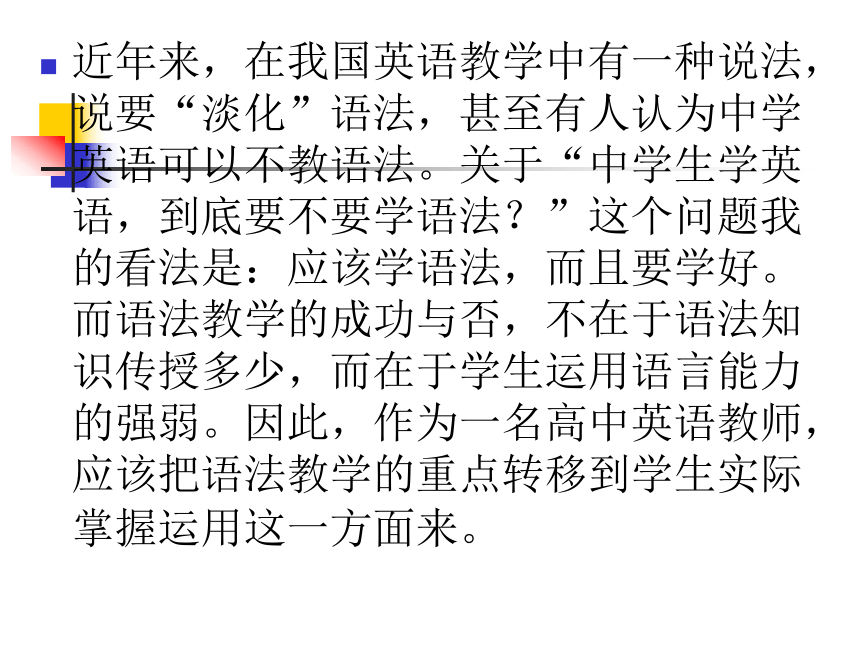

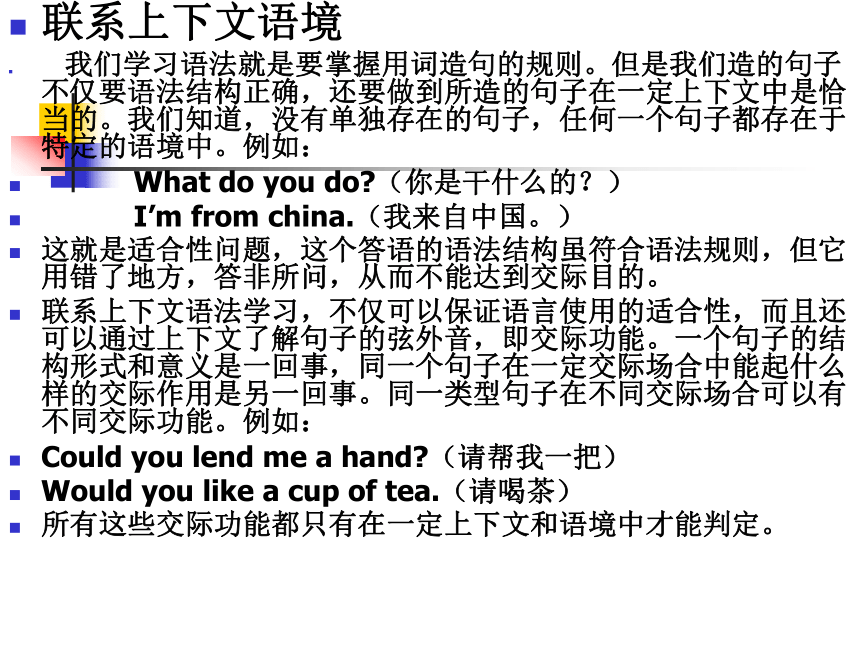
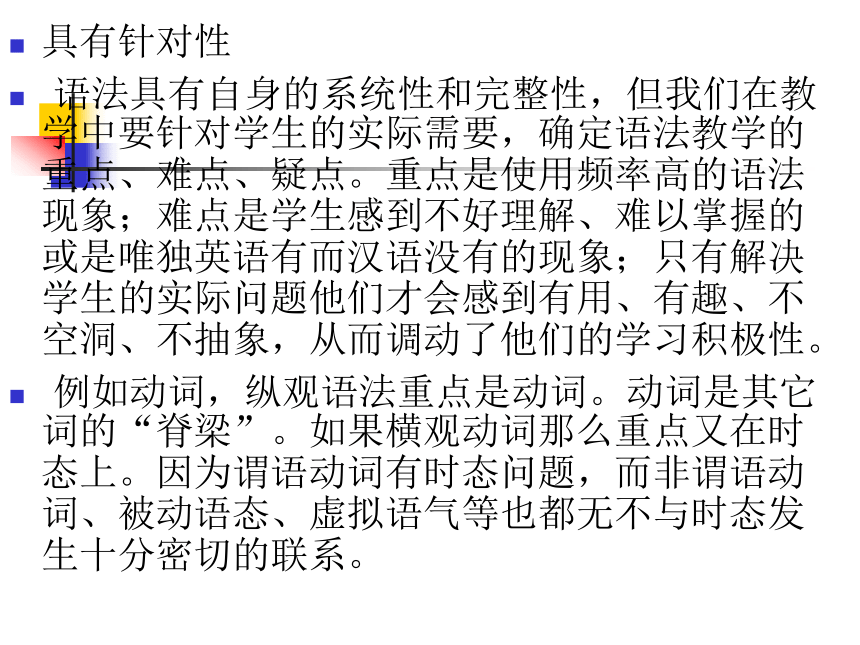
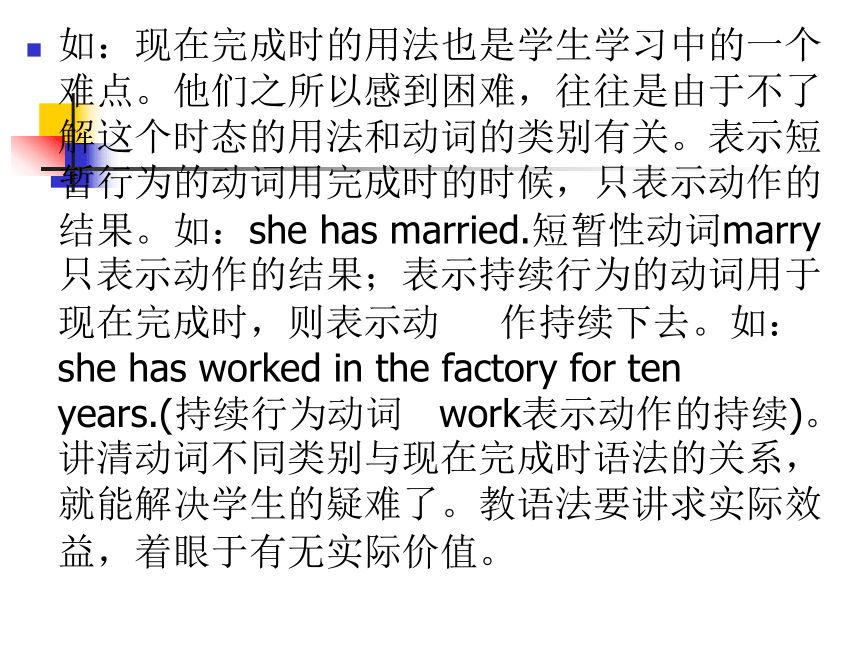

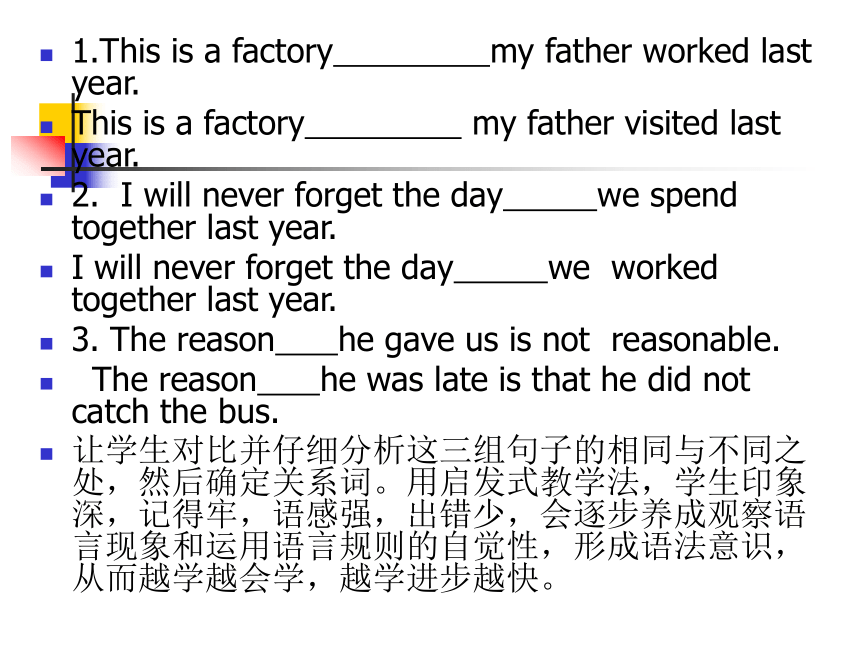

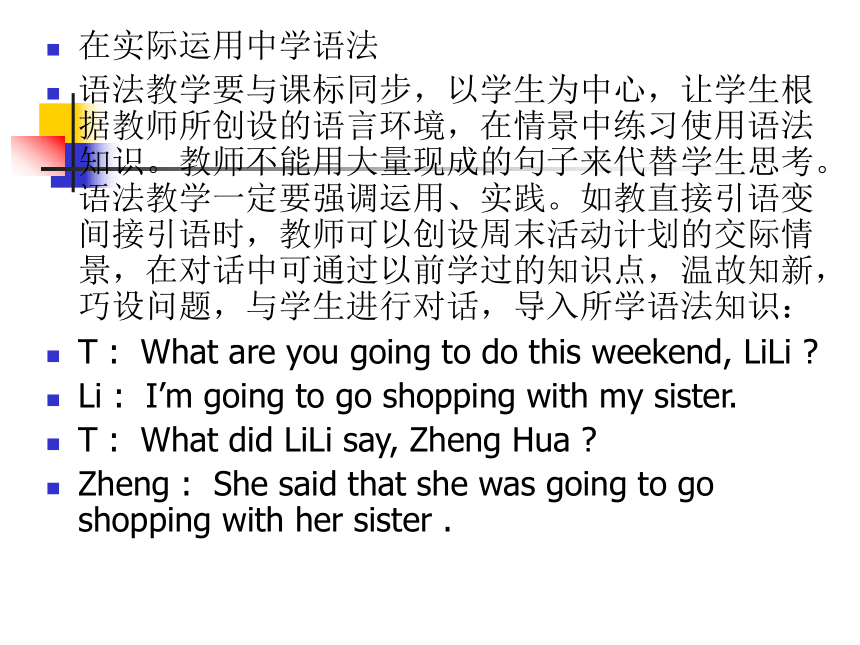


文档简介
(共54张PPT)
Heqiao Senior Middle School ,Yixi City Zhang Jian
近年来,在我国英语教学中有一种说法,说要“淡化”语法,甚至有人认为中学英语可以不教语法。关于“中学生学英语,到底要不要学语法?”这个问题我的看法是:应该学语法,而且要学好。而语法教学的成功与否,不在于语法知识传授多少,而在于学生运用语言能力的强弱。因此,作为一名高中英语教师,应该把语法教学的重点转移到学生实际掌握运用这一方面来。
讲练结合
在英语课上好语法,要立足于练。语法教学中的“练-讲-练”和“讲-听”。两种方法根本区别就在于前者立足于练,后者立足于讲。讲要求少而精,语法术语尽量少用。“练-讲-练”是就师生的双边活动而言的。从学生掌握语法规则的过程来看,就是“不自觉实践-自觉实践-不自觉实践”。即没有语法规则的初步实践到有语法规则指导下的进一步实践,最终达到不需要考虑语法规则的自动化实践,学习另一类语法规则又要经历同一个过程。如此循环反复,直到学生明白、掌握这一语法规则,运用自如为止。
联系上下文语境
我们学习语法就是要掌握用词造句的规则。但是我们造的句子不仅要语法结构正确,还要做到所造的句子在一定上下文中是恰当的。我们知道,没有单独存在的句子,任何一个句子都存在于特定的语境中。例如:
What do you do (你是干什么的?)
I’m from china.(我来自中国。)
这就是适合性问题,这个答语的语法结构虽符合语法规则,但它用错了地方,答非所问,从而不能达到交际目的。
联系上下文语法学习,不仅可以保证语言使用的适合性,而且还可以通过上下文了解句子的弦外音,即交际功能。一个句子的结构形式和意义是一回事,同一个句子在一定交际场合中能起什么样的交际作用是另一回事。同一类型句子在不同交际场合可以有不同交际功能。例如:
Could you lend me a hand (请帮我一把)
Would you like a cup of tea.(请喝茶)
所有这些交际功能都只有在一定上下文和语境中才能判定。
具有针对性
语法具有自身的系统性和完整性,但我们在教学中要针对学生的实际需要,确定语法教学的重点、难点、疑点。重点是使用频率高的语法现象;难点是学生感到不好理解、难以掌握的或是唯独英语有而汉语没有的现象;只有解决学生的实际问题他们才会感到有用、有趣、不空洞、不抽象,从而调动了他们的学习积极性。
例如动词,纵观语法重点是动词。动词是其它词的“脊梁”。如果横观动词那么重点又在时态上。因为谓语动词有时态问题,而非谓语动词、被动语态、虚拟语气等也都无不与时态发生十分密切的联系。
如:现在完成时的用法也是学生学习中的一个难点。他们之所以感到困难,往往是由于不了解这个时态的用法和动词的类别有关。表示短暂行为的动词用完成时的时候,只表示动作的结果。如:she has married.短暂性动词marry只表示动作的结果;表示持续行为的动词用于现在完成时,则表示动 作持续下去。如:she has worked in the factory for ten years.(持续行为动词 work表示动作的持续)。讲清动词不同类别与现在完成时语法的关系,就能解决学生的疑难了。教语法要讲求实际效益,着眼于有无实际价值。
启发性教学
语法教学必须贯彻启发性原则,充分调动学生的思维活动,促进学生的智力发展,使学生既能提高语言技能,又能获得语言知识。启发式教学的重点在于:不给学生现成的规则,促使学生用自己的头脑去思考问题,通过观察、对比、分析、归纳,自己悟出、自觉地操练语法规则。例如:在讲定语从句这一语法时,如何使用关系代词及关系副词,是很多学生感到困惑的一个难题,那么怎么使他们理清这个混乱的头绪呢?首先让学生看下面三组句子:
1.This is a factory my father worked last year.
This is a factory my father visited last year.
2. I will never forget the day we spend together last year.
I will never forget the day we worked together last year.
3. The reason he gave us is not reasonable.
The reason he was late is that he did not catch the bus.
让学生对比并仔细分析这三组句子的相同与不同之处,然后确定关系词。用启发式教学法,学生印象深,记得牢,语感强,出错少,会逐步养成观察语言现象和运用语言规则的自觉性,形成语法意识,从而越学越会学,越学进步越快。
注意挖掘语法的趣味性
课标强调要“激发和培养学生学习英语的兴趣”,外语教师教学语法要根据学生的年龄特征、不同的教学目的及教学条件,重视学生的全面参与,形式要多样化,以激发学生的学习兴趣。
课堂上,教师可根据所教语法项目,结合相应的交际功能和话题,采用不同的口语活动。例如,在教一般将来时be going to 这一句型时,可设计了“我的理想职业及实现理想的计划”、“新年的决心”、“周末计划”等一些语境,让学生进行角色扮演、讨论、调查等口语活动。学生乐于参与,勇于用英语表达心中所想,通过互相的谈论交流,学生自然而然地学会并掌握了be going to 这一句型及用法。
在实际运用中学语法
语法教学要与课标同步,以学生为中心,让学生根据教师所创设的语言环境,在情景中练习使用语法知识。教师不能用大量现成的句子来代替学生思考。语法教学一定要强调运用、实践。如教直接引语变间接引语时,教师可以创设周末活动计划的交际情景,在对话中可通过以前学过的知识点,温故知新,巧设问题,与学生进行对话,导入所学语法知识:
T : What are you going to do this weekend, LiLi
Li : I’m going to go shopping with my sister.
T : What did LiLi say, Zheng Hua
Zheng : She said that she was going to go shopping with her sister .
以归纳法为主,归纳法和演绎法相结合
归纳法是让学习者先接触语言材料,通过输入大量真实的、有交际性的语言实例,使其形成一定程度的感性认识,从而进行加工,最后再总结归纳出语法规则来,这一过程能够培养学生的记忆、思维、综合能力,与课程所倡导的是一致的。但演绎法也不可完全摒弃,二者应有机地结合起来,互相补充。如在进行较难的语法教学时,总结出规则后再适当举例也是可取的。
在教授直接引语和间接引语这一知识点时,可以让三位同学进行表演
1: Student A (talking to Student B):
Will you come here to attend Mary’s wedding next Saturday?
Student C (asking Student B): What did she say to you?
Student B (answering Student C): She asked me if / whether I would go there to attend Mary’s wedding the next Saturday?
2: Student A: I am staying here today.
Student B: Sorry? I could not hear you clearly.
Student A: I said that I was staying here today.
3: Teacher: We must not fall for that kind of trick.
Student A (asking Student B): What did the teacher say just now?
Student A: He warned us not to fall for that kind of trick.
对话1中的变化:come→ go, here→ there, next Saturday→ the next Saturday;而对话2中的时间、地点状语都未发生变化。而这种差异正是由于学生扮演的角色不同导致了情境发生变化造成的。学生只有身处此情此景中才能领悟语法规则在特殊语境中使用的适当性,处理好一般与特殊的关系,归纳总结出规则。
在趣味中总结归纳语法规则
尽管有人认为在外语教学条件下,显性的语法教学,即使用演绎法讲解语法规则可能优于归纳法,但对于一些繁琐规则,还是需要进行学法指导和归纳简化。
实践证明,巧妙地、趣味性的适当归纳能给语法教学带来事半功倍的效果。
我们可以采用字谜归纳法来巩固接动名词为宾语的动词。
第1步:教师在黑板上可以写下这样一串字母:mmesspcikarfeeddaaaa(译成汉语为:妹妹是不吃咖啡的啊),学生一定好奇。
第2步:教师告诉学生上面这串字母里每一个字母代表一个单词,而这些单词就是所有动词后加动名词为宾语的词语。
第3步:展开竞赛,看谁能把这些字母开头的单词写出来,谁写得最多、猜得最多就获胜(2—3分钟)
第4步:教师检查核对并讲解: m-mind, m-miss, e-enjoy, s-suggest, s-stand, p-practise, c-consider, i-imagine, k-keep,
a-advise, r-risk, f-finish, e-excuse, e-escape, d-delay, d-deny, a-admit, a-avoid,
a-appreciate, a-allow.
巧记-f结尾的名词直接加s边复数
海湾边、屋顶上,首领奴仆两相望;
谁说他们无信仰,证据写在手帕上。
gulf; roof; chief; serf;
belief; proof; handkerchief
巧记形容词排序
限定描绘大长高,形容年龄和新老。
颜色国籍出材料,作用类别往后靠。
限定词+描绘性形容词+大小、长短、高低+形状+时间、年龄+颜色+国籍、出处+材料+目的+名词(中心词)
a beautiful young Chinese girl
two short old Japanese businessmen
a little white stone bridge
a small round yellow French wooden writing desk
巧记but后面省略 to的用法
前面有 do 不带 to;无 do 后面多有 to.
1) He did nothing but watch TV and sleep last night.
2) We had no choice but to listen to him.
Revision of
the Attributive Clause
定语从句复习
高三英语第一轮复习
基础知识回顾: 关系词及其意义
指代人
指代事物
所属关系
指地点
指时间
指原因
who, whom, that, as
which, that, as
whose
where
when
why
关系代词
关系副词
归纳总结
1.that与which
2.对the way的考查
3.介词+关系代词
4.as的使用
5.对where的考查
6.综合考查
考点
难点
1) Do you have anything ______ you don’t understand
2) The only thing _____ we can do is to give you some advice.
3) Who is the man _____ is standing there
4) Her bag, in ________ she put all her money, has been stolen.
5) She heard a terrible noise, ______ brought her heart into her mouth.
that
that
that
which
which
考点1:that 与 which
1:先行词是everything, nothing, anything,
something, much, little, none等不定代词或
由不定代词any, some, no, much, few, little,
every, all等修饰时, 引导定语从句用that不用
which。
2:先行词被形容词最高级或序数词修饰且指物时,
引导定语从句用that 。
3: 先行词中既有人又有事物时,引导定语从句用
that 。
4:先行词被the very, the only等修饰且指物时,引导定
语从句用that。
5:当先行词前面有who/which等疑问代词时,只用
that。
指物,介词后。
2. 用于非限制定语从句中
只使用that应遵循的规则
只使用which应遵循的规则
填上合适的关系词并分析原因:
1.The way _________________he explained the
sentence to us was not difficult to understand. 2.The way _________________he explained to us
was quite simple.
that/ which/不填
that/in which/不填
缺状语
缺宾语
考点2:the way用做先行词
3. What surprised me was not what he said but _____ he said it. (04湖北)
A. the way B. in the way that
C. in the way D. the way which
高考题链接:
考点3:介词+关系词
1. Do you know the boy __ ____ your mother
is talking
2. He gave me some novels _____ ______ I
am not very familiar.
3. I still remember the day ___ ____ I first got
to Paris.
5. (06浙江) I was given three books on cooking,
the first ______I really enjoyed.
A. of that B. of which C. that D. which
to whom
with which
on which
This is the child whom/ that I will take care of.
4. 译:这是我要照顾的小孩。
3. ______ is known to all, he is the best student.
4. Jim passed the driving test, _____ surprised everybody in the office.
As
which
难点一:as的用法
as\that\which
1. It is such a big stone _____ nobody can lift.
2. It is such a big stone _____ nobody can lift it.
as
that
归纳:as引导限制性定语从句先行词前常被such, the same, so, as 修饰,即构成such…as , the same …as, so…as, 结构,做题时容易忽略。as在定语从句中应充当成分如:主语、宾语或表语。
as 与which引导定语从句都能指代整句内容,但定语从句位于句首时,只能用 as, 意为“正如、恰如”。
模拟训练 :
1. He is such a lazy man_____ nobody wants to work with______. (04 模拟训练)
A. as; him B. that; /
C. as; / D. whom; him
2. Mrs. Black took the police back to____ place ____ she witnessed the robbery.
A. the same; as B. the same; where
C. the same ; that D. as the same; as
(05 模拟训练)
1. I’ve come to the point where I can’t stand him.
2. The country is in the situation where a war
will break out at any time.
我已经到了无法容忍他的地步了。
国家正处在随时有可能爆发战争的局势中。
where引导的定语从句先行词大多数情况下是
表示地点的名词,但也有特殊情况。
难点二:一些特殊词之后的where
解析:如果定语从句分别修饰point, situation, part, condition和case等表示抽象意义的词,常用where 引导,意思是“到了某种地步,在某种境况中” 。
1.We are trying to reach a point ____ both sides will sit down together and talk. (06山东)
A. which B. that C. where D. when
2. ---Do you have anything to say for yourself
---Yes, there’s one point ____ we must insist on . (06江西)
A. why B. where C. how D. /
高考题链接:
做题要灵活:要分析句子成分,选择恰当的关系词。
where\that
1.This is the library_____I borrowed the book.
2.It is from this library____I borrowed the book.
where
定语从句
that
强调句型
综合考查一:定语从句与强调句
3. ---Where did you last see Mr. Smith
---It was in the hotel____ I lived.
A. that B. which
C. where D. when
难点三.综合考查
近年来,高考对定语从句和其它从句如:强调句、名词性从句和状语从句等的综合考查越来越多,这就要求考生有扎实的基础知识和较强的综合分析能力。
友情提示
综合考查二:定语从句与同位语从句
1. We all have heard the news_____ our
team won.
2. We don’t believe the news _________ he
told us yesterday.
that
that/which
综合考查三:定语从句与表语从句
The place ____ the bridge is supposed to be built should be_____ the cross-river traffic is the heaviest. (05 江苏)
A. which; where B. at which; which
C. at which; where D. which; in which
◆
that/which
1. We should go to the place_____
we are most needed.
2. We should go to the place_____
needs us most.
A. it B. where C. that D. what
B
C
3. It was October_____we met in
Damiao for the first time.
4. It was in October_____we met in
Damiao for the first time.
A. that B. which
C. when D. while
C
A
对比训练
5. He is such a good teacher_____
we all like him.
6. He is such a good teacher_____
we all like.
A. whom B. that C. as D. which
B
C
7. The news came____ the British
Queen’s mother celebrated her 101th birthday in good health, ____ isn’t surprising, because she lives an easy life and gets the best medical care.
A. that; which B. which; which
C. that; that D. when; as
(05 模拟训练)
Our class is a big family ; It consists of 40 girls and 21 boys. Most of them are mainly from the countryside. Zhang Shuai is a kind-hearted boy. He is always ready to help others. He is such a good boy that we all like him.
Our class is a big family which consists of 40 girls and 21 boys, most of whom are mainly from the countryside. Zhang Shuai is a kind-hearted boy, who is always ready to help others. He is such a good boy as we all like.
定语从句的运用
根据下列句子,完成短文。
众所周知,2008年北京已成功举办奥运会。英语作为一种国际语言,在交流中起着重要作用。作为一名高三学生,我们应抓住现在的学习机会努力学好它。只有这样,才能为我们国家今后的发展贡献自己的力量。
注意:要使用定语从句.
As is known to all, Beijing has hosted
the 2008 Olympic Games successfully. English,
which is an international language ,
played an important part in communicating with foreigners. We Senior Three students should seize this opportunity to learn it well, by which we can make our contributions to the development of our country in the future.
Practice makes perfect!
May you succeed in your studies!
Heqiao Senior Middle School ,Yixi City Zhang Jian
近年来,在我国英语教学中有一种说法,说要“淡化”语法,甚至有人认为中学英语可以不教语法。关于“中学生学英语,到底要不要学语法?”这个问题我的看法是:应该学语法,而且要学好。而语法教学的成功与否,不在于语法知识传授多少,而在于学生运用语言能力的强弱。因此,作为一名高中英语教师,应该把语法教学的重点转移到学生实际掌握运用这一方面来。
讲练结合
在英语课上好语法,要立足于练。语法教学中的“练-讲-练”和“讲-听”。两种方法根本区别就在于前者立足于练,后者立足于讲。讲要求少而精,语法术语尽量少用。“练-讲-练”是就师生的双边活动而言的。从学生掌握语法规则的过程来看,就是“不自觉实践-自觉实践-不自觉实践”。即没有语法规则的初步实践到有语法规则指导下的进一步实践,最终达到不需要考虑语法规则的自动化实践,学习另一类语法规则又要经历同一个过程。如此循环反复,直到学生明白、掌握这一语法规则,运用自如为止。
联系上下文语境
我们学习语法就是要掌握用词造句的规则。但是我们造的句子不仅要语法结构正确,还要做到所造的句子在一定上下文中是恰当的。我们知道,没有单独存在的句子,任何一个句子都存在于特定的语境中。例如:
What do you do (你是干什么的?)
I’m from china.(我来自中国。)
这就是适合性问题,这个答语的语法结构虽符合语法规则,但它用错了地方,答非所问,从而不能达到交际目的。
联系上下文语法学习,不仅可以保证语言使用的适合性,而且还可以通过上下文了解句子的弦外音,即交际功能。一个句子的结构形式和意义是一回事,同一个句子在一定交际场合中能起什么样的交际作用是另一回事。同一类型句子在不同交际场合可以有不同交际功能。例如:
Could you lend me a hand (请帮我一把)
Would you like a cup of tea.(请喝茶)
所有这些交际功能都只有在一定上下文和语境中才能判定。
具有针对性
语法具有自身的系统性和完整性,但我们在教学中要针对学生的实际需要,确定语法教学的重点、难点、疑点。重点是使用频率高的语法现象;难点是学生感到不好理解、难以掌握的或是唯独英语有而汉语没有的现象;只有解决学生的实际问题他们才会感到有用、有趣、不空洞、不抽象,从而调动了他们的学习积极性。
例如动词,纵观语法重点是动词。动词是其它词的“脊梁”。如果横观动词那么重点又在时态上。因为谓语动词有时态问题,而非谓语动词、被动语态、虚拟语气等也都无不与时态发生十分密切的联系。
如:现在完成时的用法也是学生学习中的一个难点。他们之所以感到困难,往往是由于不了解这个时态的用法和动词的类别有关。表示短暂行为的动词用完成时的时候,只表示动作的结果。如:she has married.短暂性动词marry只表示动作的结果;表示持续行为的动词用于现在完成时,则表示动 作持续下去。如:she has worked in the factory for ten years.(持续行为动词 work表示动作的持续)。讲清动词不同类别与现在完成时语法的关系,就能解决学生的疑难了。教语法要讲求实际效益,着眼于有无实际价值。
启发性教学
语法教学必须贯彻启发性原则,充分调动学生的思维活动,促进学生的智力发展,使学生既能提高语言技能,又能获得语言知识。启发式教学的重点在于:不给学生现成的规则,促使学生用自己的头脑去思考问题,通过观察、对比、分析、归纳,自己悟出、自觉地操练语法规则。例如:在讲定语从句这一语法时,如何使用关系代词及关系副词,是很多学生感到困惑的一个难题,那么怎么使他们理清这个混乱的头绪呢?首先让学生看下面三组句子:
1.This is a factory my father worked last year.
This is a factory my father visited last year.
2. I will never forget the day we spend together last year.
I will never forget the day we worked together last year.
3. The reason he gave us is not reasonable.
The reason he was late is that he did not catch the bus.
让学生对比并仔细分析这三组句子的相同与不同之处,然后确定关系词。用启发式教学法,学生印象深,记得牢,语感强,出错少,会逐步养成观察语言现象和运用语言规则的自觉性,形成语法意识,从而越学越会学,越学进步越快。
注意挖掘语法的趣味性
课标强调要“激发和培养学生学习英语的兴趣”,外语教师教学语法要根据学生的年龄特征、不同的教学目的及教学条件,重视学生的全面参与,形式要多样化,以激发学生的学习兴趣。
课堂上,教师可根据所教语法项目,结合相应的交际功能和话题,采用不同的口语活动。例如,在教一般将来时be going to 这一句型时,可设计了“我的理想职业及实现理想的计划”、“新年的决心”、“周末计划”等一些语境,让学生进行角色扮演、讨论、调查等口语活动。学生乐于参与,勇于用英语表达心中所想,通过互相的谈论交流,学生自然而然地学会并掌握了be going to 这一句型及用法。
在实际运用中学语法
语法教学要与课标同步,以学生为中心,让学生根据教师所创设的语言环境,在情景中练习使用语法知识。教师不能用大量现成的句子来代替学生思考。语法教学一定要强调运用、实践。如教直接引语变间接引语时,教师可以创设周末活动计划的交际情景,在对话中可通过以前学过的知识点,温故知新,巧设问题,与学生进行对话,导入所学语法知识:
T : What are you going to do this weekend, LiLi
Li : I’m going to go shopping with my sister.
T : What did LiLi say, Zheng Hua
Zheng : She said that she was going to go shopping with her sister .
以归纳法为主,归纳法和演绎法相结合
归纳法是让学习者先接触语言材料,通过输入大量真实的、有交际性的语言实例,使其形成一定程度的感性认识,从而进行加工,最后再总结归纳出语法规则来,这一过程能够培养学生的记忆、思维、综合能力,与课程所倡导的是一致的。但演绎法也不可完全摒弃,二者应有机地结合起来,互相补充。如在进行较难的语法教学时,总结出规则后再适当举例也是可取的。
在教授直接引语和间接引语这一知识点时,可以让三位同学进行表演
1: Student A (talking to Student B):
Will you come here to attend Mary’s wedding next Saturday?
Student C (asking Student B): What did she say to you?
Student B (answering Student C): She asked me if / whether I would go there to attend Mary’s wedding the next Saturday?
2: Student A: I am staying here today.
Student B: Sorry? I could not hear you clearly.
Student A: I said that I was staying here today.
3: Teacher: We must not fall for that kind of trick.
Student A (asking Student B): What did the teacher say just now?
Student A: He warned us not to fall for that kind of trick.
对话1中的变化:come→ go, here→ there, next Saturday→ the next Saturday;而对话2中的时间、地点状语都未发生变化。而这种差异正是由于学生扮演的角色不同导致了情境发生变化造成的。学生只有身处此情此景中才能领悟语法规则在特殊语境中使用的适当性,处理好一般与特殊的关系,归纳总结出规则。
在趣味中总结归纳语法规则
尽管有人认为在外语教学条件下,显性的语法教学,即使用演绎法讲解语法规则可能优于归纳法,但对于一些繁琐规则,还是需要进行学法指导和归纳简化。
实践证明,巧妙地、趣味性的适当归纳能给语法教学带来事半功倍的效果。
我们可以采用字谜归纳法来巩固接动名词为宾语的动词。
第1步:教师在黑板上可以写下这样一串字母:mmesspcikarfeeddaaaa(译成汉语为:妹妹是不吃咖啡的啊),学生一定好奇。
第2步:教师告诉学生上面这串字母里每一个字母代表一个单词,而这些单词就是所有动词后加动名词为宾语的词语。
第3步:展开竞赛,看谁能把这些字母开头的单词写出来,谁写得最多、猜得最多就获胜(2—3分钟)
第4步:教师检查核对并讲解: m-mind, m-miss, e-enjoy, s-suggest, s-stand, p-practise, c-consider, i-imagine, k-keep,
a-advise, r-risk, f-finish, e-excuse, e-escape, d-delay, d-deny, a-admit, a-avoid,
a-appreciate, a-allow.
巧记-f结尾的名词直接加s边复数
海湾边、屋顶上,首领奴仆两相望;
谁说他们无信仰,证据写在手帕上。
gulf; roof; chief; serf;
belief; proof; handkerchief
巧记形容词排序
限定描绘大长高,形容年龄和新老。
颜色国籍出材料,作用类别往后靠。
限定词+描绘性形容词+大小、长短、高低+形状+时间、年龄+颜色+国籍、出处+材料+目的+名词(中心词)
a beautiful young Chinese girl
two short old Japanese businessmen
a little white stone bridge
a small round yellow French wooden writing desk
巧记but后面省略 to的用法
前面有 do 不带 to;无 do 后面多有 to.
1) He did nothing but watch TV and sleep last night.
2) We had no choice but to listen to him.
Revision of
the Attributive Clause
定语从句复习
高三英语第一轮复习
基础知识回顾: 关系词及其意义
指代人
指代事物
所属关系
指地点
指时间
指原因
who, whom, that, as
which, that, as
whose
where
when
why
关系代词
关系副词
归纳总结
1.that与which
2.对the way的考查
3.介词+关系代词
4.as的使用
5.对where的考查
6.综合考查
考点
难点
1) Do you have anything ______ you don’t understand
2) The only thing _____ we can do is to give you some advice.
3) Who is the man _____ is standing there
4) Her bag, in ________ she put all her money, has been stolen.
5) She heard a terrible noise, ______ brought her heart into her mouth.
that
that
that
which
which
考点1:that 与 which
1:先行词是everything, nothing, anything,
something, much, little, none等不定代词或
由不定代词any, some, no, much, few, little,
every, all等修饰时, 引导定语从句用that不用
which。
2:先行词被形容词最高级或序数词修饰且指物时,
引导定语从句用that 。
3: 先行词中既有人又有事物时,引导定语从句用
that 。
4:先行词被the very, the only等修饰且指物时,引导定
语从句用that。
5:当先行词前面有who/which等疑问代词时,只用
that。
指物,介词后。
2. 用于非限制定语从句中
只使用that应遵循的规则
只使用which应遵循的规则
填上合适的关系词并分析原因:
1.The way _________________he explained the
sentence to us was not difficult to understand. 2.The way _________________he explained to us
was quite simple.
that/ which/不填
that/in which/不填
缺状语
缺宾语
考点2:the way用做先行词
3. What surprised me was not what he said but _____ he said it. (04湖北)
A. the way B. in the way that
C. in the way D. the way which
高考题链接:
考点3:介词+关系词
1. Do you know the boy __ ____ your mother
is talking
2. He gave me some novels _____ ______ I
am not very familiar.
3. I still remember the day ___ ____ I first got
to Paris.
5. (06浙江) I was given three books on cooking,
the first ______I really enjoyed.
A. of that B. of which C. that D. which
to whom
with which
on which
This is the child whom/ that I will take care of.
4. 译:这是我要照顾的小孩。
3. ______ is known to all, he is the best student.
4. Jim passed the driving test, _____ surprised everybody in the office.
As
which
难点一:as的用法
as\that\which
1. It is such a big stone _____ nobody can lift.
2. It is such a big stone _____ nobody can lift it.
as
that
归纳:as引导限制性定语从句先行词前常被such, the same, so, as 修饰,即构成such…as , the same …as, so…as, 结构,做题时容易忽略。as在定语从句中应充当成分如:主语、宾语或表语。
as 与which引导定语从句都能指代整句内容,但定语从句位于句首时,只能用 as, 意为“正如、恰如”。
模拟训练 :
1. He is such a lazy man_____ nobody wants to work with______. (04 模拟训练)
A. as; him B. that; /
C. as; / D. whom; him
2. Mrs. Black took the police back to____ place ____ she witnessed the robbery.
A. the same; as B. the same; where
C. the same ; that D. as the same; as
(05 模拟训练)
1. I’ve come to the point where I can’t stand him.
2. The country is in the situation where a war
will break out at any time.
我已经到了无法容忍他的地步了。
国家正处在随时有可能爆发战争的局势中。
where引导的定语从句先行词大多数情况下是
表示地点的名词,但也有特殊情况。
难点二:一些特殊词之后的where
解析:如果定语从句分别修饰point, situation, part, condition和case等表示抽象意义的词,常用where 引导,意思是“到了某种地步,在某种境况中” 。
1.We are trying to reach a point ____ both sides will sit down together and talk. (06山东)
A. which B. that C. where D. when
2. ---Do you have anything to say for yourself
---Yes, there’s one point ____ we must insist on . (06江西)
A. why B. where C. how D. /
高考题链接:
做题要灵活:要分析句子成分,选择恰当的关系词。
where\that
1.This is the library_____I borrowed the book.
2.It is from this library____I borrowed the book.
where
定语从句
that
强调句型
综合考查一:定语从句与强调句
3. ---Where did you last see Mr. Smith
---It was in the hotel____ I lived.
A. that B. which
C. where D. when
难点三.综合考查
近年来,高考对定语从句和其它从句如:强调句、名词性从句和状语从句等的综合考查越来越多,这就要求考生有扎实的基础知识和较强的综合分析能力。
友情提示
综合考查二:定语从句与同位语从句
1. We all have heard the news_____ our
team won.
2. We don’t believe the news _________ he
told us yesterday.
that
that/which
综合考查三:定语从句与表语从句
The place ____ the bridge is supposed to be built should be_____ the cross-river traffic is the heaviest. (05 江苏)
A. which; where B. at which; which
C. at which; where D. which; in which
◆
that/which
1. We should go to the place_____
we are most needed.
2. We should go to the place_____
needs us most.
A. it B. where C. that D. what
B
C
3. It was October_____we met in
Damiao for the first time.
4. It was in October_____we met in
Damiao for the first time.
A. that B. which
C. when D. while
C
A
对比训练
5. He is such a good teacher_____
we all like him.
6. He is such a good teacher_____
we all like.
A. whom B. that C. as D. which
B
C
7. The news came____ the British
Queen’s mother celebrated her 101th birthday in good health, ____ isn’t surprising, because she lives an easy life and gets the best medical care.
A. that; which B. which; which
C. that; that D. when; as
(05 模拟训练)
Our class is a big family ; It consists of 40 girls and 21 boys. Most of them are mainly from the countryside. Zhang Shuai is a kind-hearted boy. He is always ready to help others. He is such a good boy that we all like him.
Our class is a big family which consists of 40 girls and 21 boys, most of whom are mainly from the countryside. Zhang Shuai is a kind-hearted boy, who is always ready to help others. He is such a good boy as we all like.
定语从句的运用
根据下列句子,完成短文。
众所周知,2008年北京已成功举办奥运会。英语作为一种国际语言,在交流中起着重要作用。作为一名高三学生,我们应抓住现在的学习机会努力学好它。只有这样,才能为我们国家今后的发展贡献自己的力量。
注意:要使用定语从句.
As is known to all, Beijing has hosted
the 2008 Olympic Games successfully. English,
which is an international language ,
played an important part in communicating with foreigners. We Senior Three students should seize this opportunity to learn it well, by which we can make our contributions to the development of our country in the future.
Practice makes perfect!
May you succeed in your studies!
